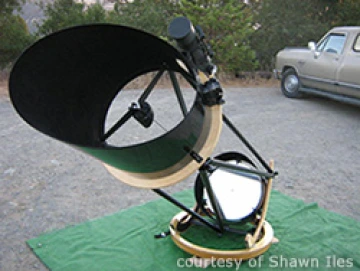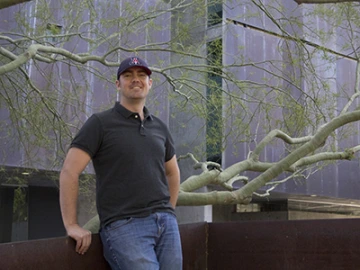Another Wavelength: Shawn Iles

This month on Another Wavelength, we meet junior Shawn Iles. Originally from Sierra Vista, he spent 25 years in California. Most recently, he lived in Santa Rosa, where he was attending Santa Rosa Junior College.
What brought you to optics?

Originally, I began college with the intention of becoming a mechanical engineer. About two years into my mechanical engineering program I learned about optical engineering (I’m a transfer student from California, not a local). I knew optical engineering would be a good match because I’ve always been fascinated with optical systems, and I used to build large telescopes for fun (see figure).
Who would you call your science hero?
My hero won’t be found in the history books. His name was Craig Holt; he was a dear friend of mine. Craig had a Ph.D. in physics and a very successful career in the sciences, but when I knew him he was retired. He never taught me advanced mathematics or physics; he just believed in me and encouraged me to peruse my interests in engineering. If it wasn’t for him I wouldn’t be finishing up my bachelor's degree.
Describe your research in 20 words or fewer.
I work under Roger Angel researching concentrated photovoltaic systems and all things related.

Describe your research in 200 words or fewer.
Concentrated solar power is just like regular solar power, but it incorporates a large mirror and usually secondary optics which focus the sun’s energy down to a very small area. If you have ever used a magnifying glass to burn something, then you probably have a good ideal of just how much energy comes from the sun. Instead of a magnifying glass, our research group uses large parabolic mirrors, but it’s the same idea. Our mirrors can melt a hole in a quarter-inch plate of steel in a matter of seconds. Of course, instead of using our mirrors to destroy things, we put a triple junction photovoltaic cell at the focus and generate a bunch of electricity. I believe the average efficiency of a conventional solar panel is about 15 to 20 percent, whereas the concentrated photovoltaic systems that we produce are around 32-percent efficient, so they’re basically awesome.
Name three neat facts about you.
- I play the piano, and I love going to the symphony.
- I've always wanted to take a trip to Europe via cargo ship – one of these days!
- I used to work at an observatory back in Santa Rosa where I gave tours of the night sky to loads of people; that job was really fun.
Figure courtesy of Shawn Iles shows an 18-inch f/4.5 Dobsonian telescope he made.
